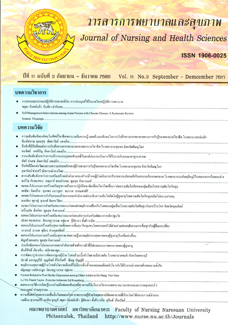The Relationship between Resulted Based Management and the Elements of Hospital Accredited by Joint Commission International
Main Article Content
Abstract
The purpose of this descriptive research was to study the relationship between results-based management and the elements of Hospital Accredited by Joint Commission International (JCI) as perceived by professional nurse in Joint Commission International (JCI) Accredited Hospitals. The research sample comprised of 288 professional nurses who had worked for more than one year in Joint Commission International (JCI) Accredited Hospitals. Stratified random sampling was used for selecting the simple.The research tool comprised three sets of questionnaires covering personel data, results-based management and elements of Hospital Accredited by Joint Commission International (JCI). These questionnaires were tested for validity and reliability. The Cronbach’s Alpha reliability coefficients of part 2 and 3 were 0.80
and 0.98 respectively. Data were analyzed by both descriptive statistics and Pearson’s product correlation coefficient. The research findings were as follows: (1) the results-based management was at the high level ( = 4.39, S.D. = 0.46). (2) The elements of Hospital Accredited by Joint Commission International (JCI) was at the high-level = 4.60, S.D. = 0.41). (3) Results based management was a statistically significant moderate positive correlation between the elements of Hospital Accredited by Joint Commission International (JCI) as perceived by professional nurse in Joint Commission International (JCI) Accredited Hospitals. ( r = .626 , p < .01 )
Article Details
References
ระหว่างโรงพยาบาลเอกชนในเขตกรุงเทพและ
ปริมณฑล : เพื่อการวางแผนนโยบาย. จุฬาลงกรณ์
เวชสาร, 42 (3),157-172.
ชัยวัช โซวเจริญสุข. (2556). ธุรกิจโรงพยาบาลเอกชน.
สืบค้นเมื่อ 20 มิถุนายน 2558, จาก http://www.
lhbank.co.th.
ณัฏฐพันธ์ เขจรนันทน์. (2551). พฤติกรรมองค์การ.
กรุงเทพฯ :วี.พริ้น.
ทิพย์วรรณ จูมแพง กุหลาบ รัตนสัจธรรม และ วัลลภ
ใจดี. (2555). ปัจจัยที่มีอิทธิพลต่อความสำเร็จ
ในการพัฒนาคุณภาพการบริหารจัดการภาครัฐ
ตามการรับรู้ของบุคคลากรในหน่วยงานระดับเขต
กระทรวงสาธารณสุข. วารสารสาธารณสุข
มหาวิทยาลัยบูรพา,7 (2),39-52.
บุญใจ ศรีสถิตย์นรากูร. (2551). ภาวะผู้นำและกลยุทธ์
การจัดการองค์การพยาบาลในศตวรรษที่ 21.
(พิมพ์ครั้งที่ 2). กรุงเทพฯ:โรงพิมพแ์ หง่
จุฬาลงกรณ์มหาวิทยาลัย.
ปัณรส มาลากุล ณ อยุธยา. (2554). การพัฒนาระบบ
ราชการไทย การพัฒนาองค์การและการสร้าง
องค์การที่เรียนรู้. สืบค้นเมื่อ 20 มิถุนายน 2558,
จาก http//km.moi.go.th/images/stories/general.
ปิยะชัย จันทรวงศ์ไพศาล. (2554). การบริหารมุ่งผล
สัมฤทธิ์. กรุงเทพฯ : บ้านหนังสือโกสินทร์.
พรทิพย์ ชมเดช. (2550). ปัจจัยที่มีอิทธิพลต่อความ
สำเร็จในการพัฒนาคุณภาพการบริหารจัดการ
ภาครัฐ : กรณีศึกษา กรมควบคุมโรค กระทรวง
สาธารณสุข. วิทยานิพนธ์ รป. ม., มหาวิทยาลัย
สุโขทัยธรรมธิราช, นนทบุรี.
เยาวภา ปฐมศิริกุล. (2554). แบบจำลองปัจจัยความสำเร็จ
การจัดการธุรกิจบริการสุขภาพของโรงพยาบาล
เอกชนในประเทศไทย. วารสารบริหารธุรกิจ,
34 (130), 15-35.
โรงพยาบาลบำรุงราษฏร์ อินเตอร์เนชั่นแนล.(2554).
โรงพยาบาลเอกชนแห่งแรกในประเทศไทย
ที่ได้รับรางวัลการบริหารสู่ความเป็นเลิศ
Thailand Quality. สืบค้นเมื่อ 17 กุมภาพันธ์
2558, จาก http://www.bumrungrad.com/tqc/
วรลักษณ์ ราชกุล. (2556). กระบวนการบริหารแบบ
มุ่งผลสัมฤทธิ์ของโรงพยาบาลสวนปรุง.
วิทยานิพนธ์ รป.ม., มหาวิทยาลัยเชียงใหม่,
เชียงใหม่.
สำนักการพยาบาล. (2554). การประกันคุณภาพการ
พยาบาล:การประเมินคุณภาพการบริการพยาบาล
ผู้ป่วยนอก. กรุงเทพฯ: สามเจริญพาณิชย์.
กองสถิติสาธารณสุข สำนักงานปลัดกระทรวงสาธารณสุข.
(2547). สถิติสาธารณสุข พ.ศ. 2547. กรุงเทพฯ :
สำนักนโยบายและแผนสาธารณสุข.
อุมาภรณ์ บุญเปี่ยม. (2557). ความสัมพันธ์ระหว่างการ
บริหารจัดการแบบมุ่งผลสัมฤทธิ์กับคุณภาพ
บริการพยาบาลตามการรับรู้ของพยาบาลวิชาชีพ
โรงพยาบาลศูนยใ์ นเครือขา่ ยบริการที่ 2. วิทยานิพนธ์
พย.ม., มหาวิทยาลัยนเรศวร, พิษณุโลก.


